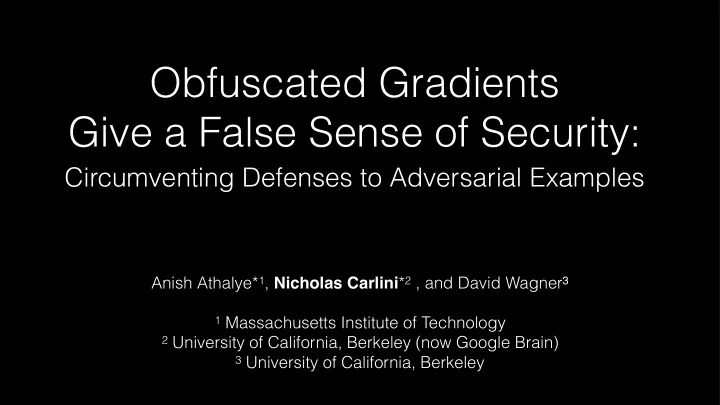

Obfuscated Gradients Give a False Sense of Security: Circumventing Defenses to Adversarial Examples Anish Athalye* 1 , Nicholas Carlini * 2 , and David Wagner 3 1 Massachusetts Institute of Technology 2 University of California, Berkeley (now Google Brain) 3 University of California, Berkeley
How and Why
Act I Background: Adversarial Examples for Neural Networks
Why should we care about adversarial examples? Make ML Make ML robust better
13 total defense papers at ICLR'18 9 are white-box, non-certified 6 of these are broken (~0% accuracy) 1 of these is partially broken
How did we evade them? Why we able to evade them?
Act II HOW: Our Attacks
How do we generate adversarial examples?
neural network loss MAXIMIZE on the given input the perturbation is less SUCH THAT than a given threshold
Why can we generate adversarial examples (with gradient descent)?
Truck Dog Airplane
( (
We find that 7 of 9 ICLR defenses rely on the same artifact: obfuscated gradients
"Fixing" Gradient Descent [0.1, 0.3, 0.0, 0.2, 0.4]
Act III WHY: Evaluation Methodology
Serious effort to evaluate By space, most papers are ½ evaluation
What went wrong then?
acc, loss = model.evaluate( x_test, y_test) Is no longer sufficient.
There is no single test set for security
The only thing that matters is robustness against an adversary targeting the defense
The purpose of a defense evaluation is NOT to show the defense is RIGHT
The purpose of a defense evaluation is to FAIL to show the defense is WRONG
Act IV Making & Measuring Progress
Strive for simplicity over complexity
What metric should we optimize?
Threat Model The set of assumptions we place on the adversary
In the context of adversarial examples: 1. Perturbation Bounds & Measure 2. Model Access & Knowledge
The threat model MUST assume the attacker has read the paper and knows the defender is using those techniques to defend.
Metrics for Success Accuracy under More permissive existing threat models threat models
"making the attacker think more" is not (usually) progress The threat model doesn't limit the attacker's approach
Act V Conclusion
A paper can only do so much in an evaluation.
A paper can only do so much in an evaluation. We need more re-evaluation papers.
So you want to build a defense? "Anyone, from the most clueless amateur to the best cryptographer, can create an algorithm that he himself can't break." -- Bruce Schneier
So you want to build a defense? As a corollary: learn to break defenses before you try to build them If you can't break the state-of-the-art, you are unlikely to be able to build on it
Challenging Suggestions Defense-GAN on MNIST We were able to break it only partially Samangouei et al . 2018 ("Defense-GAN...") "Strong" Adversarial Training on CIFAR We were not able to break it at all Madry et al. 2018 ("Towards Deep...")
Visit our poster & originally scheduled talk (Today, #110) & (Tomorrow, A7 @ 2:50) Email us Anish: aathalye@mit.edu Me: nicholas@carlini.com Track Progress Source Code robust-ml.org git.io/obfuscated-gradients
Did we get it right? 1. We reproduced the original claims against the (weak) attacks initially attempted 2. We showed the papers authors' our results 3. It's possible we didn't. But our code is public: https://github.com/anishathalye/obfuscated-gradients
Isn't this just gradient masking? The short answer: No , if it were, we wouldn't have seen 7 of 9 ICLR defenses relying on it.
X defense has multiple parts, but you only broke each part separately. True. Usually, an ensemble several weaker defenses is not an effective defense strategy, unless there is an argument they cover each other's weaknesses. He et al. "Adversarial Example Defenses: Ensembles of Weak Defenses are not Strong". WOOT'18.
Did you try X with adversarial training? Not usually. In some cases the combination is worse than adversarial training alone
Specific advice for performing evaluations - Carlini et al. 2017 & S&P ("Towards Evaluating ...") - Athalye et al. 2018 @ ICML ("Obfuscated ...") - Madry et al. 2018 @ ICLR ("Towards Deep...") - Uesato et al. 2018 @ ICML ("Adversarial Risk...") Details in our originally-scheduled talk, Tomorrow @ 2:50 in A7
There is a true notion of robustness, for a computationally unbounded adversary. We are forced to approximate this. Adversarial Risk and the Dangers of Evaluating Against Weak Attacks. Jonathan Uesato, Brendan O'Donoghue, Aaron van den Oord, Pushmeet Kohli. ICML 2018.
Recommend
More recommend